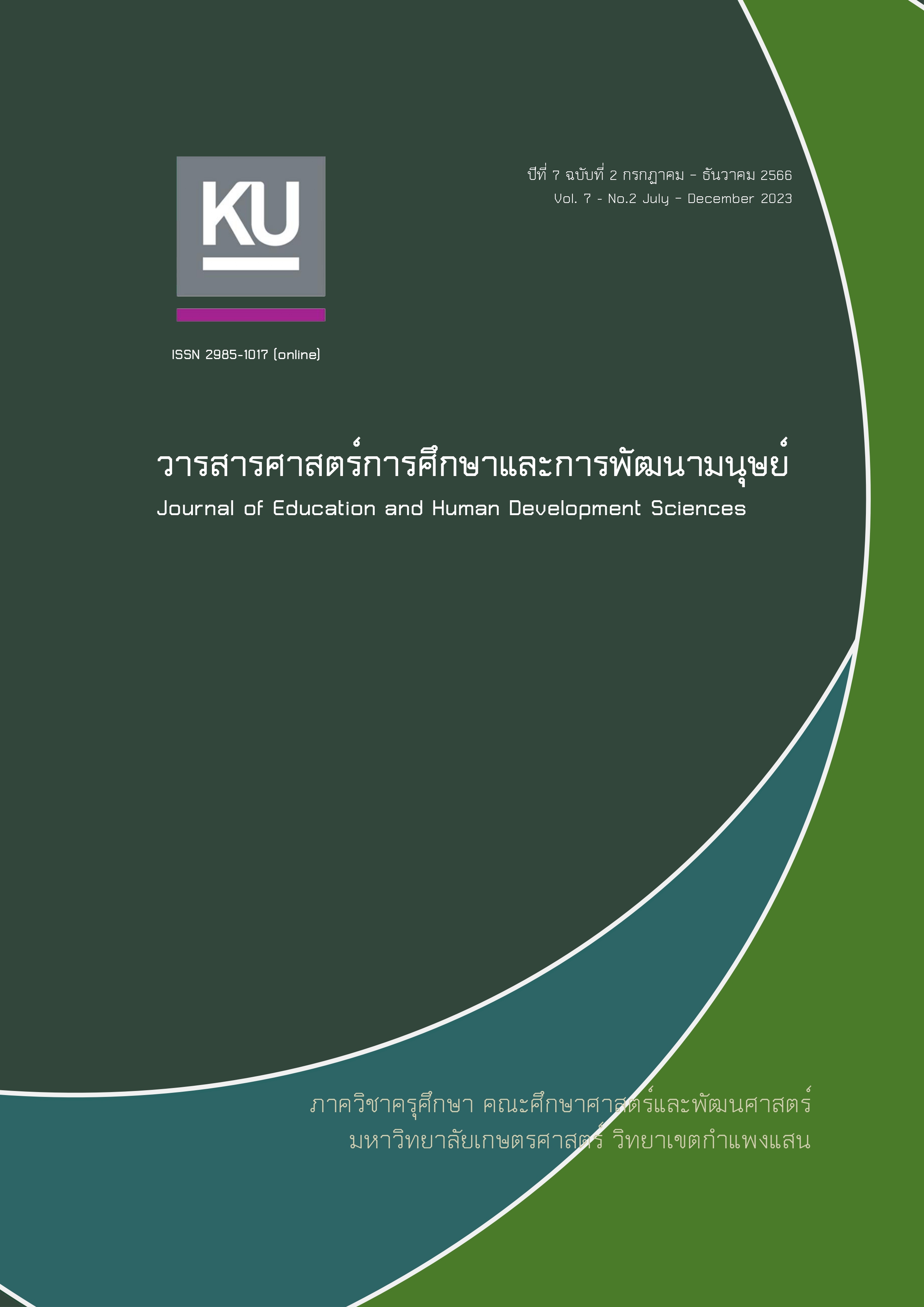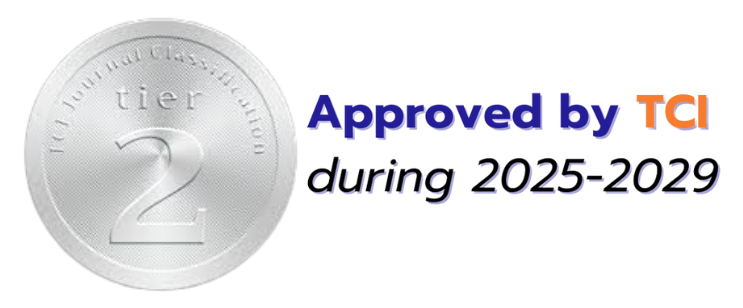ล้มแล้วลุกเร็ว: ทักษะสำคัญของครูอาจารย์เพื่อคุณภาพชีวิตที่ดี | Resilience: An Essential Skill for Teacher Well-being
Keywords:
ทักษะล้มแล้วลุกเร็ว, คุณภาพชีวิตของครูอาจารย์, กรอบแนวคิด PERMA, ทฤษฎีจิตวิทยาเชิงบวก, Resilience, Teacher Well-being, PERMA Model, Positive PsychologyAbstract
ครูอาจารย์เป็นอาชีพที่แบกรับความเครียดและความกดดันรอบด้าน ซึ่งทำให้เกิดวิกฤติภาวะหมดไฟและการลาออกของครูอาจารย์ คุณภาพชีวิตของครูอาจารย์ได้รับความสนใจมากขึ้นในวงการการศึกษาทั่วโลกในแง่ของการศึกษาปัจจัยที่ทำให้ครูอาจารย์ตัดสินใจออกจากวิชาชีพ และหนทางที่จะช่วยให้สามารถจัดการความเครียดและปัญหาจากการเรียนการสอน โดยมุ่งเน้นความร่วมมือทั้งจากตัวครูอาจารย์เองและบริบทแวดล้อม ในส่วนทักษะเฉพาะของครูอาจารย์ที่ได้รับความสนใจมากขึ้นคือทักษะล้มแล้วลุกเร็ว (Resilience) ซึ่งเป็นทักษะสำคัญที่ช่วยให้ครูอาจารย์งอกงามได้ท่ามกลางความเครียดและความกดดัน ส่งผลต่อการพัฒนาคุณภาพการเรียนการสอน แม้กระนั้นการพัฒนาครูอาจารย์โดยเฉพาะอย่างยิ่งในบริบทของประเทศไทยยังคงจำกัดอยู่ในด้านการพัฒนาทักษะความรู้ในการเป็นครู โดยที่คุณภาพชีวิตของครูในแง่ของสุขภาวะทางจิตมักถูกละเลย บทความนี้ได้รวบรวมแนวคิดการพัฒนาทักษะล้มแล้วลุกเร็วของครูอาจารย์โดยสร้างปัจจัยที่ช่วยปกป้องหรือสนับสนุนทักษะนี้จากงานวิจัยต่างๆ ผ่านกรอบแนวคิด PERMA ทฤษฎีจิตวิทยาเชิงบวก (Positive Psychology) โดยครอบคลุมถึงการพัฒนาทักษะส่วนบุคคลและการส่งเสริมจากสถาบันการศึกษา
Teaching has been found to be one of the most stressful and demanding professions, resulting in increased rates of burnout and attrition among educators. Consequently, recent educational research has shed light on the significance of teacher well-being, aiming to explore the contributing factors to teacher attrition and identify strategies for retaining teachers in the field. One of the strategies that has garnered attention is to enhance teachers’ resilience, a crucial skill for not only surviving, but thriving in the teaching profession. However, teacher well-being, especially psychological well-being is often overlooked. This is more apparent in the context of Thailand. This article focuses on strategies from the perspectives of the PERMA model in positive psychology that can enhance resilience among teachers, both on an individual level and through institutional support.
Downloads
References
and subjective career success. Journal of vocational behavior, 74(1), 53-62.
Avey, J. B., Luthans, F., & Jensen, S. M. (2009). Psychological capital: A positive resource for combating
employee stress and turnover. Human resource management, 48(5), 677-693.
Bakker, A. B., Demerouti, E., & Euwema, M. C. (2005). Job Resources Buffer the Impact of Job
Demands on Burnout. Journal of Occupational Health Psychology, 10(2), 170–180. https://doi.org/10.1037/1076-8998.10.2.170
Bandura, A. (1997). Self-efficacy: The exercise of control. New York: Freeman.
Basch, J., & Fisher, C. D. (2000). Affective events–emotions matrix: A classification of work events and
associated emotions. In N. Ashkanasy, C. Hartel, & W. Zerbe (Eds), Emotions in the workplace:
Research, theory, and practice (pp. 36–48). Westport, CT: Quorum Books.
Becker, E. S., Keller, M. M., Goetz, T., & Ranellucci, J. (2015, April). Teachers' Positive Emotions in
the Classroom: An Intraindividual Analysis on Their Antecedents. Paper presented at the Annual
Meeting of the American Educational Research Association, Chicago, Illinois.
Beltman, S., Mansfield, C., & Price, A. (2011). Thriving not just surviving: A review of research on
teacher resilience. Educational research review, 6(3), 185-207.
Beltman, S. (2021). Understanding and examining teacher resilience from multiple perspectives.
Cultivating teacher resilience, 11-26.
Benard, B. (1995). Fostering resilience in children. ERIC/EECE Digest, EDO-PS-99.
Borazon, E. Q., & Chuang, H. H. (2023). Resilience in educational system: A systematic review and
directions for future research. International Journal of Educational Development, 99, 102761.
Bottiani, J. H., Duran, C. A. K., Pas, E. T., & Bradshaw, C. P. (2019). Teacher stress and burnout in
urban middle schools: Associations with job demands, resources, and effective classroom
practices. Journal of School Psychology, 77, 36–51. https://doi.org/10.1016/j.jsp.2019.10.002.
Camitan IV, D. S., & Bajin, L. N. (2021). The importance of well-being on resiliency of Filipino adults
during the COVID-19 enhanced community quarantine: a necessary condition analysis. Frontiers
in psychology, 12, 1-13.
Capone, V., & Petrillo, G. (2020). Mental health in teachers: Relation- ships with job satisfaction, efficacy
beliefs, burnout and depres- sion. Current Psychology, 39(6), 1757–1766.
Collie, R. J., Malmberg, L. E., Martin, A. J., Sammons, P., & Morin, A. J. S. (2020). A multilevel person-
centered examination of teachers’ workplace demands and resources: Links with work-related
well-being. Frontiers in Psychology, 11. https://doi.org/10.3389/fpsyg.2020.00626.
Csikszentmihalyi, M. (1990). Flow: The Psychology of Optimal Experience. New York: Harper and Row.
Csikszentmihalyi, M. (2002). Flow: The classic work on how to achieve happiness. London: Rider Books.
Day, C., & Gu, Q. (2014). Resilient teachers, Resilient Schools. London: Routledge.
Day, C., Kington, A., Stobart, G., & Sammons, P. (2006). The personal and professional selves of
teachers: Stable and unstable identities. British educational research journal, 32(4), 601-616.
Desimone, L. M. (2009). Improving Impact Studies of Teachers’ Professional Development: Toward
Better Conceptualizations and Measures. Educational Researcher, 38(3), 181-199.
Donohoo, J. (2017). Collective teacher efficacy: The effect size research and six enabling conditions.
Journal of Professional Capital and Community, 2(2), 101-116.
Drew, S. V., & Sosnowski, C. (2019). Emerging theory of teacher resilience: A situational analysis.
English Teaching: Practice & Critique, 18(4), 492-507.
Falecki, D., & Mann, E. (2021). Practical Applications for Building Teacher WellBeing in Education. In
C.F., Mansfield (Ed.), Cultivating Teacher Resilience (pp.175-191). Springer, Singapore.
https://doi.org/10.1007/978-981-15-5963-1_11
Fernandes, L., Gouveia, M.J., Castro Silva, J., Peixoto, F. (2020). ‘Positive Education’: A Professional
Learning Programme to Foster Teachers’ Resilience and Well-Being. In C.F., Mansfield (Ed.),
Cultivating Teacher Resilience (pp.103-124). Springer, Singapore.
Fredrickson, B. L., & Losada, M. F. (2005). Positive affect and the complex dynamics of human
flourishing. American psychologist, 60(7), 678-686.
Fredrickson, B. L. (2004). The broaden–and–build theory of positive emotions. Philosophical transactions
of the royal society of London. Series B: Biological Sciences, 359(1449), 1367-1377.
Fredrickson, B. L. (2004). Gratitude, like other positive emotions, broadens and builds. In R. A. Emmons
& M. E. McCullough (Eds.), The psychology of gratitude (pp. 145–166). Oxford Press.
Fredrickson, B. L. (2006). Unpacking positive emotions: Investigating the seeds of human flourishing.
The Journal of Positive Psychology, 1(2), 57-59.
Fredrickson, B. L. (2013). Positive emotions broaden and build. In P. Devine, and A. Plant (Eds.),
Advances in experimental social psychology (pp. 1–53). Elsevier.
Gasper K., & Clore, K.L. (2002). Attending to the big picture: mood and global versus local processing
of visual information. Psychological science, 13(1), 34–40.
Gibbs, S., & Miller, A. (2014). Teachers’ resilience and well-being: A role for educational psychology.
Teachers and Teaching, 20(5), 609-621.
Gibson, S., & Dembo, M. H. (1984). Teacher efficacy: A construct validation. Journal of Educational
Psychology, 76(4), 569–582. https://doi.org/10.1037/0022-0663.76.4.569
Goh, P. S., Goh, Y. W., Jeevanandam, L., Nyolczas, Z., Kun, A., Watanabe, Y., ... & Jiang, J. (2022).
Be happy to be successful: A mediational model of PERMA variables. Asia Pacific Journal of
Human Resources, 60(3), 632-657.
Grant, A. M., Green, L. S., & Rynsaardt, J. (2010). Developmental coaching for high school teachers:
Executive coaching goes to school. Consulting Psychology Journal: Practice and Research, 62(3),
151–168. https://doi.org/10.1037/a0019212
Gu, Q., & Day, C. (2013). Challenges to teacher resilience: Conditions count. British educational
research journal, 39(1), 22-44.
Harms, P. D., Brady, L., Wood, D., & Silard, A. (2018). Resilience and well-being. Handbook of well-
being. Salt Lake City, UT: DEF Publishers.
Helgesen, M. (2016). Happiness in ESL/EFL: Bringing positive psychology to the classroom. In P. D.
MacIntyre, T. Gregersen, & S. Mercer (Eds.), Positive Psychology in SLA (pp. 305–323). Multilingual Matters.
Holmes, E. (2019). A practical guide to teacher wellbeing. SAGE Publications.
Hoy, A. W., & Spero, R. B. (2005). Changes in teacher efficacy during the early years of teaching: A
comparison of four measures. Teaching and teacher education, 21(4), 343-356.
Hiver, P. (2018). Teachstrong: the power of teacher resilience for L2 practitioners. In S. Mercer. & A.
Kostoulos (Eds), Language Teacher Psychology (pp. 231-246). Bristol: Multilingual Matters.
Hiver, P., & Dörnyei, Z. (2017). Language teacher immunity: A double-edged sword. Applied Linguistics,
38(3), 405-423.
Intasit, S., & Chulkeeree, S. (2009). Turn Bad into Good: RQ The power of mental health to gracefully
take you through crisis and uncertainty of life. https://dmh-elibrary.org/items/show/168 [translated]
Isaksen, J. (2000). Constructing meaning despite the drudgery of repetitive work. Journal of Humanistic
Psychology, 40(3), 84-107. doi: 10.1177/002216780040300
Jamjuree, D. (2017). Teacher training and development in Thailand. Journal of Research and Curriculum
Development, 7-19.
Jordan, J. (2013). Relational Resilience in Girls. In Goldstein, S. & Brooks, R. (Eds.), Handbook of Resilience in Children (2nd ed., pp. 73-86), New York: Springer.
Kahn, W.A. (1990). Psychological conditions of personal engagement and disengagement at work.
Academy of Management Journal, 33, 692–724.
Kerdtip, C., & Inmonthian, P. (2023). Analyzing How Relationships, Determination, Dedication, and
Gratitude Affect Teacher Resilience in Top-Tier Competitive Secondary Schools in Thailand.
Journal of Positive Psychology and Wellbeing, 7(2), 763-782.
Klanrit, P., & Sroinam, R. (2012). EFL teacher's anxiety in using English in teaching in the language
classroom. International Journal of Social Science and Humanity, 2(6), 493.
Klassen, R., Wilson, E., Siu, A. F., Hannok, W., Wong, M. W., Wongsri, N., ... & Jansem, A. (2013).
Preservice teachers’ work stress, self-efficacy, and occupational commitment in four countries.
European journal of psychology of education, 28, 1289-1309.
Knight, J., & van Nieuwerburgh, C. (2012). Instructional coaching: A focus on practice. Coaching: An
International Journal of Theory, Research and Practice, 5(2), 100-112.
Kowitarttawatee, P., & Limphaibool, W. (2022). Fostering and sustaining teacher resilience through
integration of Eastern and Western mindfulness. Cogent Education, 9(2097470), 1-15.
Kubovy, M. (1999). On the pleasures of the mind. “Well-being: The foundations of hedonic psychology”.
New York: Russell Sage.
Kun, A., Balogh, P., & Krasz, K.G. (2017). Development of the work-related well-being questionnaire
based on Seligman’s PERMA model. Periodica Polytechnica Social and Management Sciences,
25(1), 56-63.
Lautongmeesakun, S., & Wichian, S. N. (2016). Path analysis of work passion model of Thai teachers
in municipal Schools. International Journal of Information and Education Technology, 6(12), 949.
Lavy, S., & Littman-Ovadia, H. (2017). My better self: Using strengths at work and work productivity,
organizational citizenship behavior, and satisfaction. Journal of Career Development, 44(2), 95-
109. https://doi.org/10.1177/0894845316634056.
Le Cornu, R. (2013). Building early career teacher resilience: The role of relationships. Australian
Journal of Teacher Education, 38(4), 1-16.
Luthar, S. S., Cicchetti, D., & Becker, B. (2000). The construct of resilience: A critical evaluation and
guidelines for future work. Child development, 71(3), 543-562.
Lyubomirsky, S. (2008). The how of happiness: A scientific approach to getting the life you want. New
York: Penguin Press.
Mascaro, N., & Rosen, D. (2006). The Role of Existential Meaning as a Buffer Against Stress. Journal
Of Humanistic Psychology, 46(2), 168-190. http://dx.doi.org/10.1177/0022167805283779
Maslach, C., & Jackson, S. E. (1981). The measurement of experienced burnout. Journal of
Occupational Behaviour, 2, 99-113.
Masten, A. S., Best, K., & Garmezy, N. (1990). Resilience and development: Contributions from the
study of children who overcome adversity. Development and Psychopathology, 2, 425–444.
McCallum, F. (2021). Teachers’ wellbeing during times of change and disruption. In Wellbeing and
Resilience Education (pp. 183-208). Routledge.
McGaughey, F., Watermeyer, R. P., Shankar, K., Suri, V. R., Knight, C., Crick, T., Hardman, J., Phelan,
D., & Chung, R. Y-N. (2021). ‘This can’t be the new norm’: academics’ perspectives on the
COVID-19 crisis for the Australian University Sector. Higher Education Research and
Development. https://doi.org/10.1080/07294360.2021.1973384
Mullen, C. A., Shields, L. B., & Tienken, C. H. (2021). Developing teacher resilience and resilient school
cultures. Journal of Scholarship & Practice, 18(1), 8-24.
Ninkovic, S., Floric, O. K., & Dordic, D. (2022). The effect of teacher trust in colleagues on collective
teacher efficacy: Examining the mediating role of the characteristics of professional learning
communities. Teaching and Teacher Education, 119, 103877.
Ong, A., Bergeman, C. and Boker, S. (2009). Resilience comes of age: Defining features in later
adulthood. Journal of Personality, 77(6), 1777-1804.
Papatraianou, L.H., Strangeways, A., Beltman, S., Schuberg Barnes, E., 2018. Beginning teacher
resilience in remote Australia: a place-based perspective. Teach Teach, 24(8), 893–914.
Park, J., & Baumeister, R. F. (2017). Meaning in life and adjustment to daily stressors. The Journal of
Positive Psychology, 12(4), 333-341.
Parker, P. D., & Martin, A. J. (2009). Coping and buoyancy in the workplace: Understanding their effects
on teachers’ work-related well-being and engagement. Teaching and Teacher Education, 25(1),
68–75. https://doi.org/10.1016/j.tate.2008.06.009.
Patterson, J. H., Collins, L., & Abbott, G. (2004). A study of teacher resilience in urban schools. Journal
of Instructional Psychology, 31(1), 3-11.
Podesta, E., & Hoath, L. (Eds.) (2023). Professional studies for secondary teaching. Learning Matters
Ltd.
Prabjandee, D. (2014). Journey to Becoming a Thai English Teacher: New Perspective on Investigating
Teacher Attrition. Alberta Journal of Educational Research, 60(3), 522-537.
Ratanasiripong, P., Ratanasiripong, N.T., Nungdanjark, W., Thongthammarat, Y. and Toyama, S. (2022).
Mental health and burnout among teachers in Thailand, Journal of Health Research, 36(3), 404-
416. https://doi.org/10.1108/JHR-05-2020-0181
Reich, J. W., Zautra, A. J., & Hall, J. S. (Eds.). (2010). Handbook of adult resilience. Guilford Press.
Robinson, L. E., Valido, A., Drescher, A., Woolweaver, A. B., Espelage, D. L., LoMurray, S., ... & Dailey,
M. M. (2023). Teachers, stress, and the COVID-19 pandemic: A qualitative analysis. School
mental health, 15(1), 78-89.
Rodríguez-Mantilla, J. M., & Fernández-Díaz, M. J. (2017). The effect of interpersonal relationships on
burnout syndrome in secondary education teachers. Psicothema, 29(3), 370–377.
https://doi.org/10.7334/psicothema2016.309.
Roffey, S. (2012). Pupil wellbeing—Teacher wellbeing: Two sides of the same coin? Educational and
Child Psychology, 29(4), 8–17.
Sakharov, M., & Farber, B. A. (1983). A critical study of burnout in teachers. Stress and burnout in the
human service professions, 65, 81.
Sammons, P., Day, C., Kington, A., Gu, Q., Stobart, G., & Smees, R. (2007). Exploring variations in
teachers' work, lives and their effects on pupils: key findings and implications from a longitudinal
mixed-method study. British educational research journal, 33(5), 681-701.
Seligman, M. E. (2011). Building resilience. Harvard business review, 89(4), 100-106.
Sheldon, K. M., & Lyubomirsky, S. (2006). How to increase and sustain positive emotion: The effects
of expressing gratitude and visualizing best possible selves. The Journal of Positive Psychology,
1(2), 73-82. https://doi.org/10.1080/17439760500510676.
Skaalvik, E. M., & Skaalvik, S. (2020). Teacher burnout: Relations between dimensions of burnout,
perceived school context, job satisfaction and motivation for teaching. A longitudinal study.
Teachers and Teaching, 26(7–8), 602–616. https://doi.org/10.1080/13540602.2021.1913404
Skaalvik, E. M., & Skaalvik, S. (2014). Teacher self-efficacy and perceived autonomy: Relations with
teacher engagement, job satisfaction, and emotional exhaustion. Psychological Reports, 114(1),
68-77.
Skinner, N., & Brewer, N. (2002). The dynamics of threat and challenge appraisals prior to stressful
achievement events. Journal of personality and social psychology, 83(3), 678.
Sribayak, V., Tangkiengsirisin, S., & Hongboontri, C. (2018). Factors influencing teacher attrition in a
Thai context. LEARN Journal: Language Education and Acquisition Research Network, 11(2), 84-102.
Stegen, A., & Wankier, J. (2018). Generating gratitude in the workplace to improve faculty job
satisfaction. Journal of Nursing Education, 57(6), 375–378. https://doi.org/10.3928/01484834-
20180522-10
Street, H. (2018). Contextual wellbeing. Subiaco, Australia: Wise Solutions Books.
Snyder, C. R., Rand, K. L., & Sigmon, D. R. (2002). Hope theory: A member of the positive psychology
family. In C. R. Snyder & S. J. Lopez (Eds.), Handbook of positive psychology (pp. 257–276).
Oxford University Press.
Super, S., Wagemakers, M. A. E., Picavet, H. S. J., Verkooijen, K. T., & Koelen, M. A. (2016).
Strengthening sense of coherence: opportunities for theory building in health promotion. Health
promotion international, 31(4), 869-878.
Tsai, W. C., Chen, C. C., & Liu, H. L. (2007). Test of a model linking employee positive moods and task
performance. Journal of Applied Psychology, 92(6), 1570-1583.
Vermote, B., Aelterman, N., Beyers, W., Aper, L., Buysschaert, F., & Vansteenkiste, M. (2020). The role
of teachers’ motivation and mindsets in predicting a (de) motivating teaching style in higher
education: A circumplex approach. Motivation and emotion, 44, 270-294.
Viac, C., & Fraser, P. (2020). Teachers’ well-being: A framework for data collection and analysis (OECD
Education Working Papers), No.213. Paris: OECD Publishing. https://doi.org/10.1787/c36fc9d3-
en
Waters, L., & White, M. (2015). Case study of a school wellbeing initiative: Using appreciative inquiry
to support positive change. International Journal of Wellbeing, 5(1), 19–32. https://doi.
org/10.5502/ijw.v5i1.2.
Wiroko, E. P., & Sugiharti, D. (2022). Gratitude and work engagement: The mediating role of employee
resilience. INSPIRA: Indonesian Journal of Psychological Research, 3(2), 38-50.
Wolgast, A., & Fischer, N. (2017). You are not alone: Colleague support and goal-oriented cooperation
as resources to reduce teachers’ stress. Social Psychology of Education, 20, 97-114.
Xanthopoulou, D., Bakker, A. B., Demerouti, E., & Schaufeli, W. B. (2009). Reciprocal relationships
between job resources, personal resources, and work engagement. Journal of Vocational
Behavior, 74(3), 235–244.
Yoon, J. S. (2002). Teacher characteristics as predictors of teacher–student relationships: Stress,
negative affect, and self-efficacy. Social Behavior and Personality: an international journal, 30,
485–493.
Yuen, M., & Datu, J. A. D. (2021). Meaning in life, connectedness, academic self-efficacy, and personal
self-efficacy: A winning combination. School Psychology International, 42(1), 79–99.
Zhang, L., Chen, J., Li, X., & Zhan, Y. (2023). A Scope Review of the Teacher Well-being Research
Between 1968 and 2021. The Asia-Pacific Education Researcher, 1-16.







